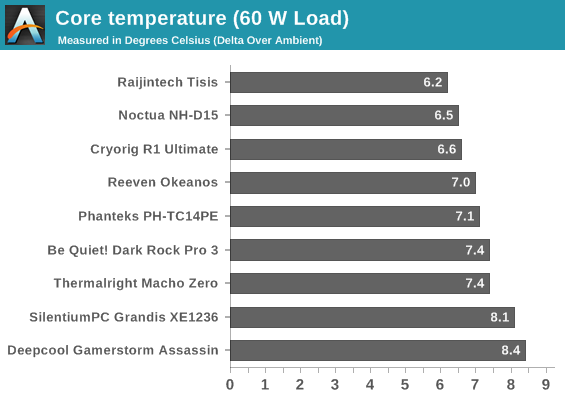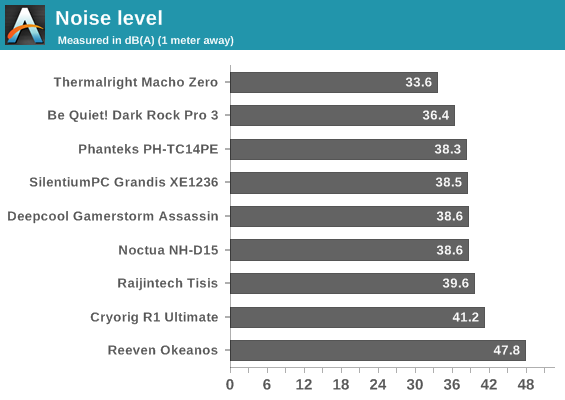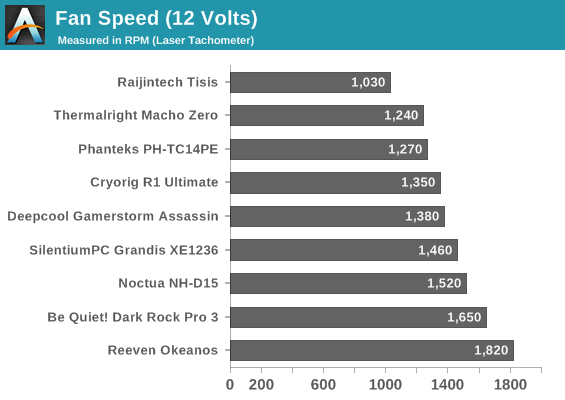Top Tier CPU Air Coolers Q3 2015: 9-Way Roundup Review
by E. Fylladitakis on July 6, 2015 8:00 AM ESTTesting results, maximum fan speed (12 Volts)


| Core Temperature, Constant Thermal Load |
|
|


*Note: When the cooler has two different fans, the fan speed of the faster fan is recorded.
We should start by noticing that one should be extremely careful when reading the performance charts. Even though some of the coolers are of similar design or size, their performance differs greatly. Similarly, coolers with similar thermal performance may have great differences in size, acoustics and or price.
Without a doubt, the grandest example of this warning is the Okeanos. Reeven's offering outpaces nearly every other cooler, comparing directly with Noctua's and Cryorig's finest, when tested at our maximum load and has the best average absolute thermal resistance. However, this is not due to excelling technology or design. On the contrary, the Okeanos is simpler and smaller than most of the coolers in this review. This achievement is simple brute force through high speed fans, which places the Okeanos far behind any other offering on acoustics.
Not unexpectedly, the thermal performance charts are being led by the Noctua NH-D15, the Cryorig R1 Ultimate and the Phanteks TC14PE. These are the best coolers of the most renowned manufacturers, so one would expect interative designs over time to yield benefits. The performance differences between these three offerings, thermal and acoustic alike, are very small. Raijintech's Tisis is the surprise of this review, with similar thermal and acoustics performance to that of the best coolers. The Tisis also has the best low load performance, where the charts shift greatly.
The Dark Rock Pro 3 from Be Quiet! offers lower noise levels but falls a little behind on thermal performance. Not the same can be said about Deepcool's offering, the Assassin, which does not match the thermal performance of the best coolers but is neither quieter nor notably cheaper. The performance gap is rather small but the Assassin is at a disadvantage. The Grandis falls even further behind in terms of thermal performance while the noise levels are similar, but SilentiumPC designed it to be more budget-friendly than other offerings, not to compete with the elite on terms of raw performance. Thermalright's Macho Zero is also an inconsistency in this review, as this cooler is not meant to provide maximum thermal performance and hits the bottom of our absolute thermal resistance charts. On the other hand, the Macho Zero paired with the TY147A is by far the quietest cooler in this review, being whisper-quiet even while the fan is spinning at maximum speed.










135 Comments
View All Comments
marraco - Monday, July 6, 2015 - link
Something really important that never is reviewed is dust control and maintenance.As radiator fins get closer, they have more dissipation area, but air flow gets worse. Yet the main problem of fins closeness is that they accumulate dust much faster, and get occluded.
No review makes a dust test. I have a Thermaltake cooler, which works excellent when is clean, but it rapidly loses his capacity due to being occluded by dust.
The easiest way to remove his dust is to use canned air, but it is a short lived fix, because an air cleaned radiator occludes itself very fast, sometimes in matter of weeks.
The only way to clean it for good is to take out the dissipator, and put in in the dish washer. But that is a cumbersome task. I need to do a lot of work just to clean it, and I need thermal paste to place it again on the motherboard.
So, maintenance is as important as cooling and noise.
A good cooler should pass a dusting test (being exposed to a day of dirty and dusty air current), and should be possible to clean it without much hassle, without applying thermal paste, without using screws, without need to access both sides of the motherboard, and without his pegs breaking or being degraded by manipulation.
'nar - Tuesday, July 7, 2015 - link
Interesting concern. It makes sense, yet is never considered. I think the best answer is the same as electricity, you need to provide the best environment you can for your computer. Higher quality components are more sensitive to dirty power, and dusty air. Get that PC off the floor, and get a case with good dust filters. And if your room is bad enough, get an room air filter. I have one on my desk right in front of my PC. A Honeywell HEPA air filter.Impulses - Monday, July 6, 2015 - link
I understand why cases are tested with stock fans, replacing 3+ quality fans will significantly alter the price equation... It's a trivial difference for $50-100 heatsinks tho, many are often even sold sans fans anyway.If nothing else, a single apples to apples test with all running the same fan would've been welcome. In addition to something like the Hyper 212 as a baseline, the different Thermalright TRUE Spirit variants have remained a solid value over the years (they perform better than the 212 and even closer to some of these as per HardOCP's last roundup).
Is there gonna be a midrange roundup? Spending upwards of $65 on an air cooler never made much sense to me when more affordable options were so close in both noise and performance. Out of 9 coolers tested only 3 or so come in at a sensible price, at $75+ wouldn't it make more sense to go AIO WC?
xthetenth - Monday, July 6, 2015 - link
If you want low noise, good thermals and dead quiet idle well into the land of diminishing returns, high end air is still a very compelling alternative to water, especially if you're willing to put the effort into some ducting.However midrange products can be excellent and are well worth a good long look before hanging a hundred bucks off your socket.
'nar - Tuesday, July 7, 2015 - link
I was a HSF fanboy until I actually needed a water cooling system. Specs and testing does not show response time. Fast, transient loads can overwhelm a HSF, as heat pipes cannot transfer heat as fast as water. For low power CPU's a HSF is fine, but when you go over 100 watts the noise is less of an issue, as a HSF will need much more airflow to compare to the higher heat transfer ability of W/C. And instantaneous loads are more likely to cause system instability due to the less efficient heat transfer rates of heatpipes.meacupla - Tuesday, July 7, 2015 - link
I am going to nitpick on what you're saying there, because you have it confused.Heatpipes use some form of vaporized liquid inside and they actually transmit heat quite good, especially when compared against sold copper rods. Where they fail, is that they do not have a lot of capacity for transferring large amounts of heat.
Water is actually quite poor at transmitting heat, as it's a non-metal and an insulator. It does, however, have great capacity to hold heat.
This is why large bodies of water are warm during winter and cold during summer and results in mild weather near the coast and extreme weather in the interior.
The advantage of water cooling systems, over air cooling, is the ability to place large radiators, with a lot of surface area, in spots that get fresh air from outside the case, instead of warmed up air that is already inside the case. Heatsinks are also limited to size and weight constraints around the socket.
Were it possible to attach a triple 120mm fan heatpipe heatsink, as in parallel layout, instead of serial dual towers, directly to the CPU, I'm quite sure the results would be similar to a 360mm radiator water cooling setup.
xthetenth - Tuesday, July 7, 2015 - link
Yeah, he's describing the thermal mass of the coolant, not any transfer capability. It seems that running coolant through radiator fins does have an advantage of relying on the fins to radiate the heat out from a heatpipe, but for a similar surface area, it's questionable how large the advantage is, especially at CPU TDPs.GPUs on the other hand have a more constrained form factor for large air cooling and a higher TDP, so they are a more promising place for CLCs.
PitneFor - Monday, July 6, 2015 - link
wheres Prolimatech, my precious...mejobloggs - Monday, July 6, 2015 - link
I'd be very interested to see a size-per-performance chart.I usually buy coolers that perform the best without being too large. Although I guess "Top Tier" coolers isn't the right article to look for smaller size coolers :p
Impulses - Monday, July 6, 2015 - link
Leaving it to the manufacturers to select their entry is always messy or questionable IMO, TR choosing the Macho over the Silver Arrow for one... Still curious whether there's a midrange round up planned or if this is it for air coolers at AT for a couple more years...Despite the criticism I do appreciate E Fyll's thorough process, otherwise I imagine I and many others wouldn't even bother commenting. Low end (212+) and high end ($120 AIO?) base lines would make the article much more useful tho.
The into even suggests some people prefer high end air over WC at the start but then leaves that up in the air... No pun intended.